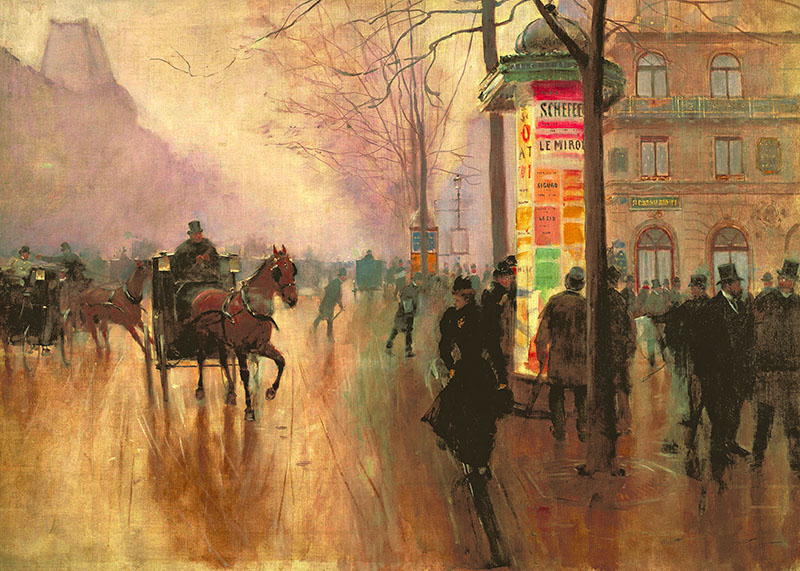Reading Visual Art: 188 Poster, adverts

In this second article looking at examples of the use of posters in paintings, and how their contents can be relevant, I move on to the last couple of decades of the nineteenth century. By this time large-format colour printing was churning out unprecedented numbers of posters that were being stuck onto walls in public places. These promoted events and products, and the advertising industry was starting to flourish. Posters included in paintings had largely been associated with poverty.
Jean-Eugène Buland (1852–1926), Alms of a Beggar (1880), oil on canvas, 117 × 89 cm, location not known. Wikimedia Commons.
In France, Naturalists like Jean-Eugène Buland took on challenging motifs with challenging readings. In Alms of a Beggar (1880), a young woman dressed immaculately in white is sat outside a church seeking charity. Approaching her, a coin in his right hand, is a man who can only be a beggar himself. His clothes are patched on patches, faded and filthy, and he wears battered old wooden shoes. Yet he is about to give the young woman what is probably his last coin. Buland uses two small posters as decorations, one pinned to the white tablecloth at the left, the other attached to the wooden door at the right.
Those artists like Jean Béraud who were recording street scenes of Paris in the Belle Époque often featured posters.
Jean Béraud (1849–1935), A Windy Day on the Pont des Arts (1880-1), oil on canvas, 39.7 × 56.5 cm, The Metropolitan Museum of Art, New York, NY. Wikimedia Commons.
Béraud’s view of A Windy Day on the Pont des Arts from 1880-1 contains several fascinating details, such as the man carrying his fishing rod among the stream of top-hatted gentlemen. Posters at the right advertise the Fête de Sèvres, held annually in that town each June, but this clearly isn’t a pleasant summer’s day.
Jean Béraud (1849–1935), Parisian Street Scene (c 1885), oil on panel, 38.7 × 26.8 cm, The Metropolitan Museum of Art, New York, NY. Wikimedia Commons.
Working from his customised studio carriage, Béraud developed a particular affection for the street kiosks that had sprung up on so many corners, and were covered with posters. Parisian Street Scene, claimed to date from about 1885, is one example, on the Boulevard des Italiens from the corner of the Rue Laffitte.
Jean Béraud (1849–1935) Carriages on the Boulevard des Italiens (1890), further details not known. The Athenaeum.
Béraud’s Carriages on the Boulevard des Italiens shows the same kiosk in the golden light of a winter’s afternoon. However, this view is purported to have been painted in 1890, five years after the Parisian Street Scene above. It isn’t credible that the posters illuminated in the kiosk have remained identical over that period.
Fernand Pelez (1848-1913), Homeless (1883), oil on canvas, 77.5 x 136 cm, location not known. Image by Bastenbas, via Wikimedia Commons.
Just as in London a few years before, posters continue to feature in the background of paintings of those living on the streets. Fernand Pelez’ Homeless from 1883 was exhibited at the Salon in Paris that year, where those viewing it only needed to walk round the corner from the Palais des Champs-Élysées (where it was held) to see scenes like this for real. Posters again refer ironically to festivals, and deliver information about traffic management in Paris.
Jean-François Raffaëlli (1850-1924), Guests Waiting for the Wedding (before 1884), oil on panel, 52.5 x 68.5 cm, Musée d’Orsay, Paris. Wikimedia Commons.
Jean-François Raffaëlli’s Guests Waiting for the Wedding, from before 1884, are stood outside a wedding room that has, like them, seen better days. Behind them are official notices concerning dogs, an appeal for military reservists, and other local matters.
Évariste Carpentier (1845–1922), The Foreigners (1887), oil on canvas, 145 x 212 cm, Koninklijke Musea voor Schone Kunsten van België / Musées Royaux des Beaux Arts de Belgique, Brussels, Belgium. Wikimedia Commons.
Évariste Carpentier’s The Foreigners from 1887 shows the arrival of outsiders in a close-knit community. At the right, sat at a table under the window, a mother and daughter dressed in black indicating recent bereavement are the foreigners looking for hospitality. Instead, everyone in the room, and many of those in the crowded bar behind, stares at them as if they have just arrived from Mars. At the left edge are two posters apparently promoting local events, to which these foreigners presumably aren’t invited.
Paul Hoeniger (1865–1924), Spittelmarkt (1912), media and dimensions not known, Stiftung Stadtmuseum Berlin, Berlin. Wikimedia Commons.
By the early twentieth century posters had grown into large hoardings shown in Paul Hoeniger’s view of Berlin’s Spittelmarkt from 1912. With the advent of motor vehicles came the visual excesses of the advertising industry that still wants to own everything we see today.




